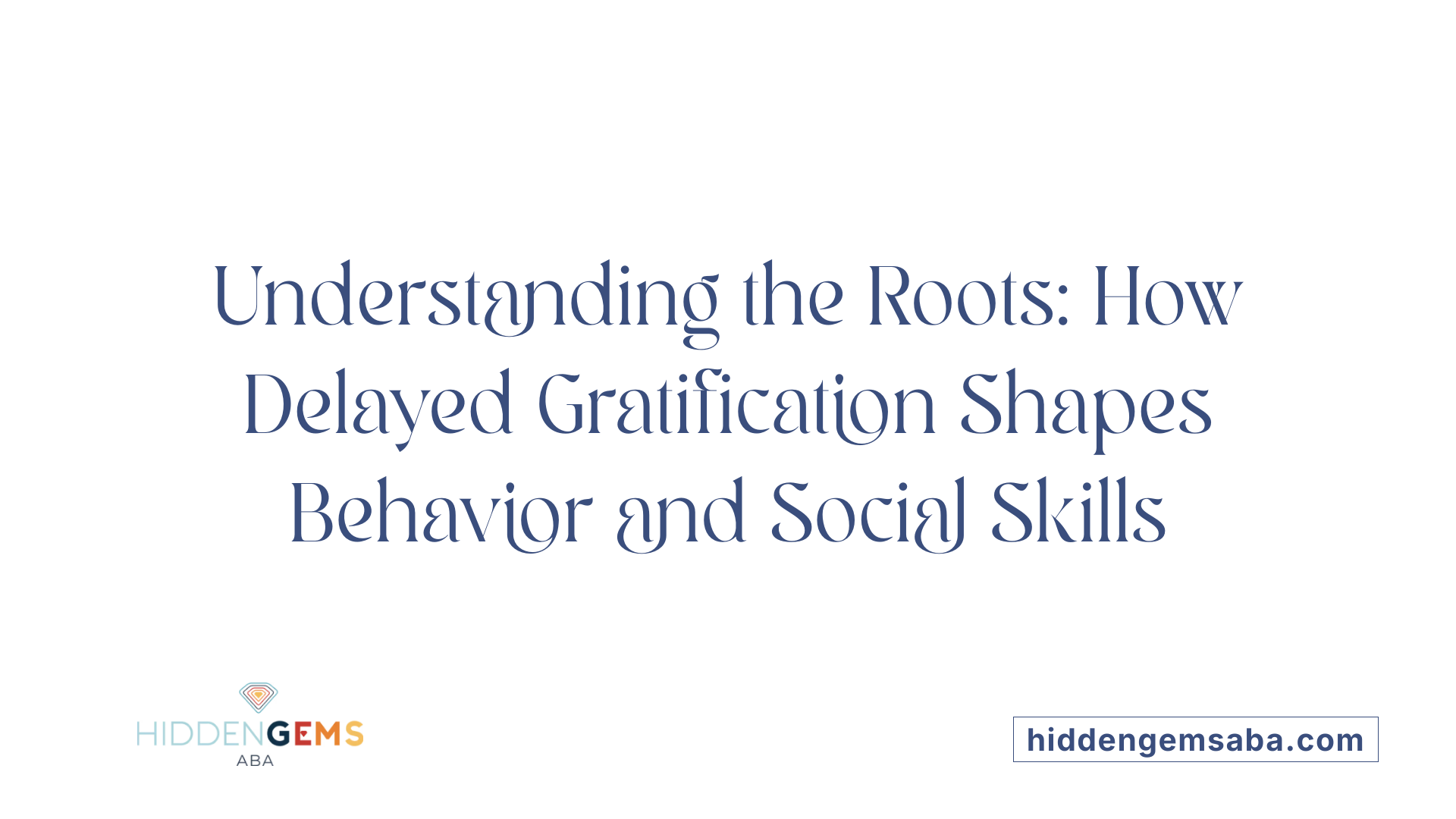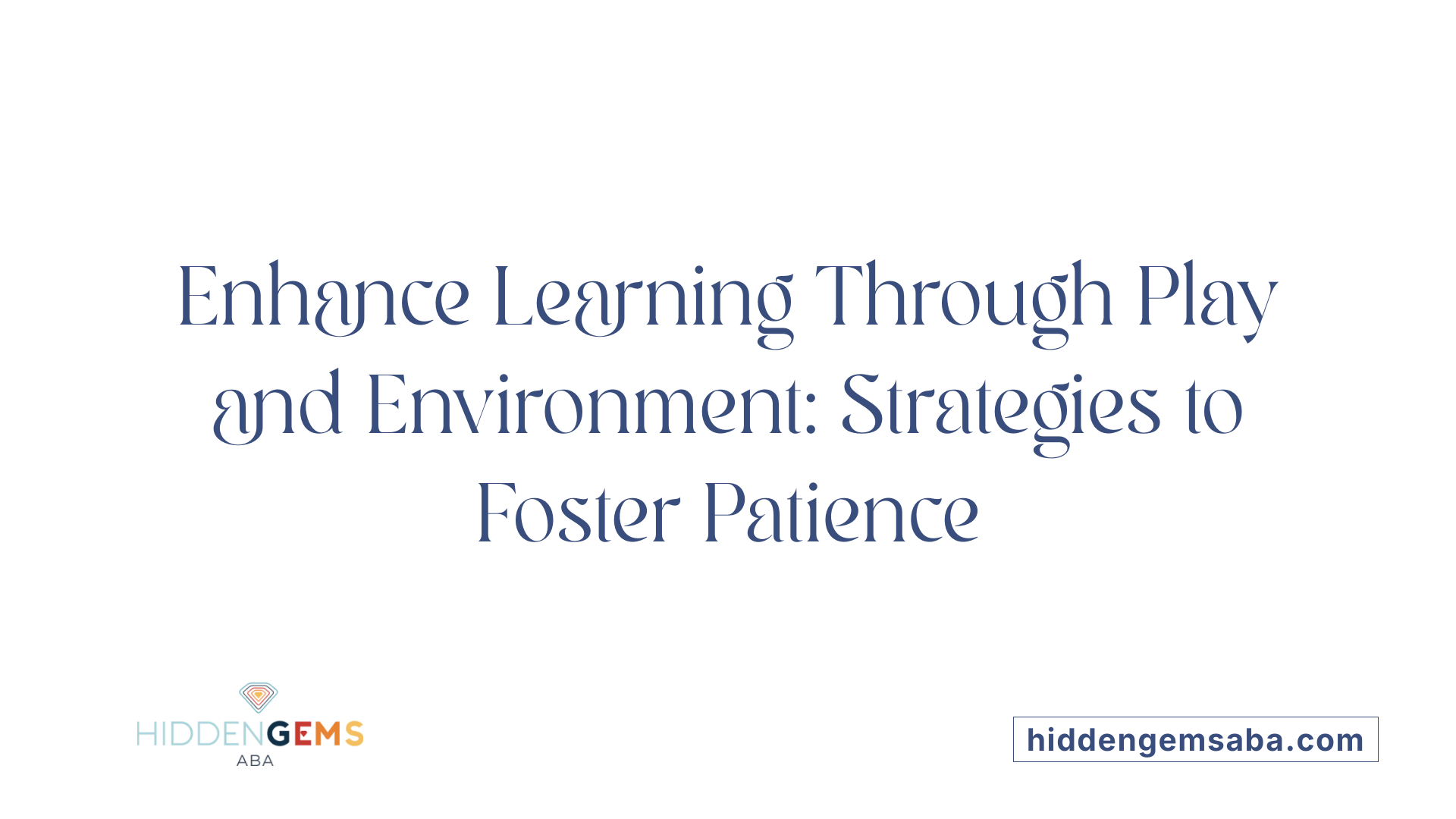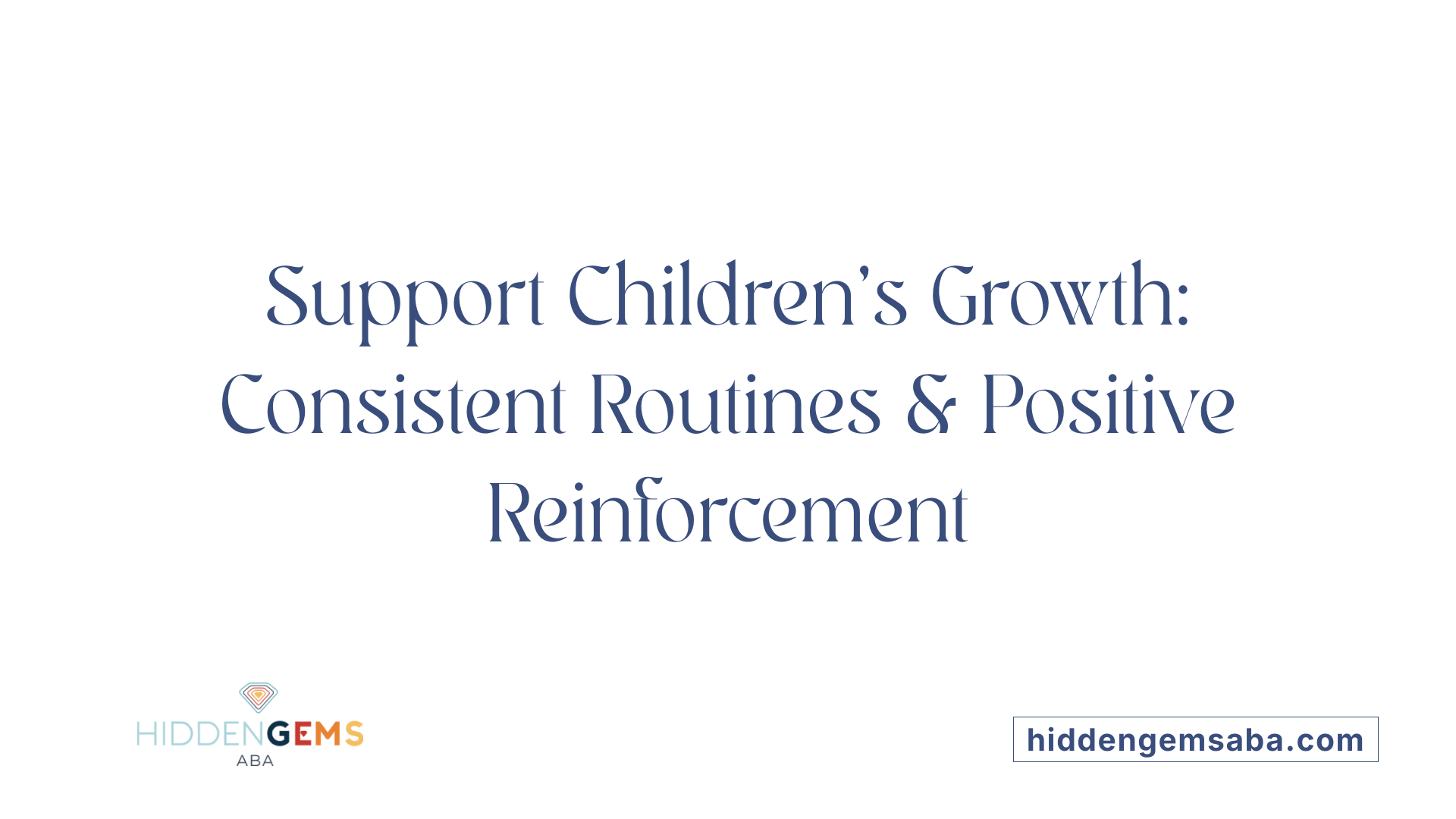Understanding the Importance of Delayed Gratification in Child Development
Developing the ability to delay gratification is fundamental to children’s behavioral and social growth. Particularly for children with autism spectrum disorder (ASD), mastering this skill can significantly reduce challenging behaviors, enhance emotional regulation, and promote social competence. ABA (Applied Behavior Analysis) therapy has emerged as a scientifically validated approach to help children cultivate patience and self-control, laying a foundation for success in various life domains.
The Psychological Foundations of Delayed Gratification

Why is developing delayed gratification important for children's behavioral and social development?
Learning to delay gratification plays a significant role in shaping a child's behavior and social skills. When children can resist immediate temptations, they cultivate patience and improve their ability to manage frustrations. These skills are crucial for positive social interactions, as they help children respond thoughtfully rather than impulsively during social exchanges.
Research links the capacity for delayed gratification with long-term benefits, including better academic achievement, healthier weight management, and increased resilience to stress. Kids who develop this skill tend to stay more focused on their goals and handle setbacks more effectively.
The environment surrounding a child, particularly the consistency and reliability of caregivers, greatly influences their ability to delay gratification. Trustworthy and responsive caregiving fosters a sense of safety and predictability, which encourages children to wait and persevere.
Cultural norms and peer influences also play a role. In cultures where cooperation and patience are valued, children learn to wait more readily, enhancing their social responsibility and group cohesion.
Ultimately, teaching delayed gratification equips children with essential social skills such as self-control and trust. These foundational skills support their ongoing behavioral development and prepare them for long-term success in various life domains.
The Role of Autonomy and Environment in Learning Patience
Why is developing delayed gratification important for children's behavioral and social development?
Developing the ability to delay gratification plays a significant role in shaping a child's behavior and social skills. Children who learn to wait for a reward, rather than seeking immediate satisfaction, tend to exhibit better impulse control and patience. These qualities are crucial for positive social interactions, as they enable children to manage frustrations and respond appropriately in social settings.
Research shows that children with strong delayed gratification skills often achieve higher academic success, maintain healthier weight, and cope better with stress. These benefits extend into their long-term life success, promoting emotional regulation and perseverance.
The environment and caregiver influence are vital in fostering these skills. Consistent routines and reliable caregiving create a predictable setting, which helps children feel secure and encourages patience. When caregivers model calm, patient behaviors and provide structured opportunities for children to practice waiting, children learn through observation and experience.
Cultural norms and peer interactions further support this development. Social settings that value cooperation and sharing teach children the importance of waiting their turn, promoting social responsibility. Children observe and imitate behaviors that are reinforced within their environment, making positive routines and trustworthy relationships essential.
The influence of visual prompts, choices, and structured delays in teaching patience cannot be understated. Visual cues provide clarity and reduce anxiety around waiting, while offering choices gives children a sense of control, making the process of waiting more manageable.
In summary, cultivating delayed gratification hinges on a supportive environment, consistent caregiver modeling, and strategic use of choices and visual aids. These elements combine to help children develop self-control, trust, and social competence, laying a foundation for successful personal and social development.
ABA Techniques for Developing Delayed Gratification
What methods and strategies does ABA therapy use to develop delayed gratification in children?
Applied Behavior Analysis (ABA) offers a structured way to help children, especially those with Autism Spectrum Disorder (ASD), learn to delay gratification. The core idea is to shape behaviors through positive reinforcement and systematic techniques.
One common method involves using visual prompts. These could be pictures, charts, or symbols that help children understand what is expected and what they can earn if they wait patiently. Visual aids make abstract concepts more concrete and accessible for children with ASD.
Clear rewards tied to desirable behaviors also motivate children to develop patience. Rewards are immediate and specific, such as praise, tokens, or preferred activities, which are delivered consistently when the child demonstrates self-control.
Breaking down long-term goals into smaller, manageable steps is another effective strategy. Instead of expecting a child to wait for a significant reward from the outset, the process begins with short delays or smaller incentives, gradually increasing as the child's tolerance grows.
Offering choices plays a vital role in fostering autonomy. When children select activities or rewards, they feel more in control, reducing frustration and increasing motivation to wait. For example, a child might choose between two preferred toys, knowing that their patience will lead to the opportunity.
Structured environments that minimize distractions and temptations are crucial. ABA therapists often create predictable routines and clear expectations, which help children learn self-regulation. Recognizing signs of discomfort or impulsivity allows caregivers to intervene appropriately and support the child's emotional regulation.
In addition, activity-based techniques like mindfulness exercises, encouraging children to use self-directed speech (
Play-Based Strategies and Environmental Modifications in ABA

What approaches, including play-based strategies and environmental modifications, are used in ABA to promote delayed gratification?
In ABA (Applied Behavior Analysis), a variety of tailored strategies are implemented to help children develop patience and self-control through play and environmental adjustments. These methods are designed to create engaging and supportive settings where children can practice delaying gratification in a natural and meaningful context.
One common approach involves integrating play-based activities such as role play, outdoor play, and board games. These activities not only make learning enjoyable but also provide opportunities for children to test and strengthen their impulse control. For example, turn-taking games like board games require children to wait their turn, helping them practice patience.
Environmental modifications further support delayed gratification by structuring the surroundings to promote self-regulation. This includes clear visual cues, designated quiet areas, and routine schedules that reduce anxiety and impulsivity.
A central tool used in ABA is the Token Economy System. This involves giving children tokens as immediate reinforcement for demonstrating self-control or waiting behavior. These tokens can be saved and exchanged later for more meaningful rewards, such as preferred activities or items. This method encourages children to link patience with attainable rewards, reinforcing their ability to wait.
ABA programs also incorporate gradual increases in the required delay before rewards are given, a process called fading. Starting with short delays, therapists and caregivers steadily extend wait times, helping children build tolerance for longer periods of waiting.
Through these combined strategies—play, environmental supports, token economies, and progressive delay training—children with autism learn the importance and benefits of delaying gratification. This comprehensive approach not only reduces problematic behaviors like meltdowns but also enhances long-term self-regulation and social functioning.
Research Evidence Supporting ABA in Delay of Gratification

Are there studies on training with probabilistic outcomes?
Research involving probabilistic reinforcement schedules has shown promising results in training children to delay gratification. In particular, studies utilizing video-game based delay tasks found that children trained with probabilistic outcomes demonstrated a significantly higher likelihood of waiting during testing phases compared to those trained with reward magnitude. This suggests that unpredictability in reinforcement can effectively promote patience.
Furthermore, when contingencies were no longer differential—meaning the rewards became equal or unpredictable—the behavior of delayed gratification persisted. Children continued to wait more than their baseline levels, indicating that training with probability outcomes fosters generalization of patience.
How effective are fading procedures and reinforcement schedules?
Fading procedures involve gradually increasing the delay to a reward, which helps children build tolerance for waiting. Studies have shown that systematic fading, especially when combined with probabilistic reinforcement, enhances the ability to wait patiently. For example, gradually increasing the delay in reinforcement during a training task leads to longer waiting times.
Reinforcement schedules also play a crucial role. Using reinforcement when children demonstrate self-control—such as waiting—reinforces patience. Probabilistic and fading reinforcement schedules work together to improve delay tolerance.
Can delaying behaviors be generalized?
Generalization of delaying behavior is vital for real-world application. Training methods that incorporate variable reinforcement, including probability-based methods, have resulted in better transfer of delay behaviors outside the training environment. Children trained with these methods tended to wait even when dependencies on specific cues or conditions were removed.
This indicates that behavior learned through probabilistic outcomes and fading reinforcement schemes can extend beyond the training context, helping children develop patience in everyday situations.
How does environment manipulation assist in delay development?
Creating supportive environments involves assessing and adjusting aspects of choice scenarios by considering delay length, reinforcement consistency, and the type of rewards offered. Such environments promote self-control and patience by reinforcing desirable behaviors.
Consistent modeling by caregivers, combined with structured routines and clear expectations, enhances children's understanding and ability to manage impulses.
What are recommended strategies for teaching delayed gratification?
Effective training includes the use of visual prompts, offering choices to children, incorporating activities during delays, and giving children control over their learning process.
Fading delays gradually, providing positive reinforcement for waiting, and using engaging tasks during waiting periods further promote patience.
Additionally, playing impulse control games and engaging in activities like role-play, outdoor play, and mindfulness exercises support self-regulation skills.
How does ABA support the development of delay of gratification?
ABA therapy, grounded in behavior analysis principles, is highly supported by research for increasing tolerance for delayed gratification, particularly in children with autism spectrum disorder (ASD). Its systematic use of reinforcement, behavior shaping, and individualized strategies makes it adaptable and effective.
Studies show that children with ASD generally struggle more with delaying gratification compared to their typically developing peers. However, targeted ABA interventions employing visual prompts, choice-making, and reinforcement schedules improve these skills.
ABA techniques promote emotional regulation, impulse control, and patience, which are essential for social adaptation and long-term success. The emphasis on consistency and reinforcement ensures that children learn and generalize delay behavior across settings.
In conclusion, ABA offers a scientifically validated framework for teaching delayed gratification, helping children develop crucial self-control skills that underpin their overall growth and adaptation.
Training for Caregivers and Educators

How can consistency, modeling, and reinforcement techniques support delay of gratification?
Establishing consistent routines and behavior expectations is fundamental when teaching children, especially those with autism, to delay gratification. Caregivers and educators should model patience and self-control to serve as clear examples for children to imitate. Positive reinforcement plays a vital role: praise efforts when the child demonstrates patience or waits for a larger reward, helping to reinforce these behaviors.
Using reinforcement strategies such as token economies or praise when a child successfully resists temptation encourages continued practice. Incorporating routine activities like setting clear goals and using visual cues or prompts can also help children understand what is expected, increasing their chances of success.
Why is creating supportive environments for practicing delay important?
A supportive environment minimizes temptations and distractions, making it easier for children to practice delaying gratification. This can include removing objects that are tempting or providing alternative activities during waiting periods. Activities like role play, outdoor play, or engaging puzzles help children develop patience in a natural setting.
Creating predictable routines and offering choices can also foster a sense of control, which supports their ability to wait and strengthen self-regulation over time. Using structured activities with built-in delays — such as turn-taking games or waiting for their turn in groups — naturally teach self-control skills.
How can involving parents enhance reinforcement strategies?
Parents are essential partners in reinforcing delay of gratification at home. Consistent strategies across environments strengthen learning and generalization. Educating parents about the importance of positive reinforcement, patience, and modeling helps ensure that children experience consistent messaging.
Parent training on specific ABA techniques — like praise, token systems, or engaging in conversation about future rewards — can enhance the effectiveness of these strategies. Incorporating engaging activities such as board games, saving accounts, or activity-based delays can translate learned skills from therapy sessions into daily life, supporting long-term development.
Resources and Tips for Supporting Children in Developing Delayed Gratification
Parents and caregivers can utilize a variety of evidence-based methods to promote delay of gratification:
| Strategy | Description | Benefit |
|---|---|---|
| Use of positive reinforcement | Praising efforts and celebrating small successes | Builds motivation and patience |
| Visual cues and prompts | Charts, timers, or visual signs to indicate waiting periods | Enhances understanding of expectations |
| Fun distractions during delays | Engaging activities or toys to divert attention during wait | Increases tolerance for waiting |
| Incorporating self-talk | Teaching children to verbalize their intentions or future rewards | Fosters self-regulation and executive functioning |
| Play-based delay exercises | Games like 'Stop, Go', relay races, or turn-taking activities | Develops impulse control in an enjoyable way |
| Consistent routines and clear goals | Structured daily schedules and specific expectations | Creates predictability and security |
By integrating these practical tips and evidence-backed techniques into daily routines, caregivers and educators can foster a child's ability to delay gratification. Over time, this skill supports increased self-control, better emotional regulation, and improved social and academic outcomes.
Long-Term Benefits and Outcomes of Developing Delay of Gratification

How can developing delay of gratification influence a child's future?
Children who learn to delay gratification tend to achieve better outcomes across many areas of life. For example, in academics, they often demonstrate higher success because they can focus and persist through challenging tasks without immediate rewards.
In terms of social skills, delay of gratification fosters patience and impulse control, enabling children to build healthier relationships. They become better at managing emotions, cooperating with peers, and navigating social situations effectively.
Moreover, children with strong delay abilities tend to cope better with stress. They can regulate their feelings during difficult moments, which supports emotional resilience and overall mental health.
How are habits and long-term achievement connected?
Developing the capacity for delay of gratification encourages the formation of positive habits like goal-setting, self-control, and perseverance. These habits, once ingrained, support ongoing personal growth and achievement.
Practicing patience and self-regulation translates to perseverance in long-term projects, academic pursuits, and future careers. These skills help children adapt to challenges and stay committed to larger goals.
How does ABA therapy support learning delay of gratification?
Applied Behavior Analysis (ABA) employs structured strategies to improve self-control and patience among children with autism. It involves teaching children to manage impulses, use visual prompts, and understand rewards, which are often delayed or probabilistic.
ABA harnesses reinforcement principles to gradually extend waiting times—fading delays, providing choices, or integrating activities during waiting periods. These techniques help children internalize self-control behaviors.
Research shows that ABA methods lead to increased tolerance for longer delays, which generalize beyond therapy settings to everyday life situations. This improved ability to wait and regulate impulses promotes greater independence and success.
How do delayed gratification skills affect children with ASD?
Children with ASD often display reduced effortful control and difficulty delaying gratification, impacting their social development and daily functioning. By focusing on developing these skills through specialized behavioral approaches, they can improve their social interactions and reduce behaviors like impulsivity and frustration.
Enhancing their self-control can also lower the severity of social and emotional symptoms, supporting overall progress in therapy and life skills.
| Area of Impact | Benefit | Supporting Details |
|---|---|---|
| Academic Success | Better focus and perseverance | Children who delay gratification can work longer on tasks and achieve higher academic results. |
| Social Skills | Improved patience and cooperation | Learning to wait and regulate impulses fosters healthier relationships. |
| Stress Management and Emotions | Greater emotional resilience | Ability to wait and control impulses helps children manage stress effectively. |
| Personal Growth and Achievement | Development of positive habits | Delayed gratification promotes goal-setting and sustained effort over time. |
Understanding and nurturing the ability to delay gratification can have far-reaching effects. It promotes not only immediate self-control but also long-term personal development, academic success, and social competence, especially when supported by proven approaches like ABA and play-based activities.
Fostering Future Success Through Patience and Self-Control
Incorporating ABA therapy to develop delayed gratification is a transformative approach that supports children’s behavioral, emotional, and social development. By systematically teaching patience, offering structured environments, and utilizing evidence-based techniques like visual prompts and reinforcement, ABA helps children improve their self-control and emotional regulation. These skills are vital for achieving academic success, forming healthy relationships, and managing stress effectively. Early intervention and consistent practice, combined with active caregiver involvement, significantly enhance a child's capacity to wait and persevere, ultimately leading to better life outcomes. As research continues to reinforce the benefits of ABA in fostering patience, it is increasingly evident that this approach provides children with the tools they need for lifelong success.
References
- Delaying Gratification: An Essential Skill for Autistic Children to Learn
- LEARNING TO WAIT FOR MORE LIKELY OR JUST MORE
- Delayed reinforcement and self-control: Increasing tolerance for ...
- Delayed Gratification | Master Impulse Control with These Tips
- Playing for Patience: Using Play to Help Young Children Delay ...
- 10 WAYS TO TEACH KIDS DELAYED GRATIFICATION
- Reduced delay of gratification and effortful control among young ...
- Therapeutic options for children with autism - Forta Health
- Delaying Gratification: An Essential Skill for Autistic Children to Learn





